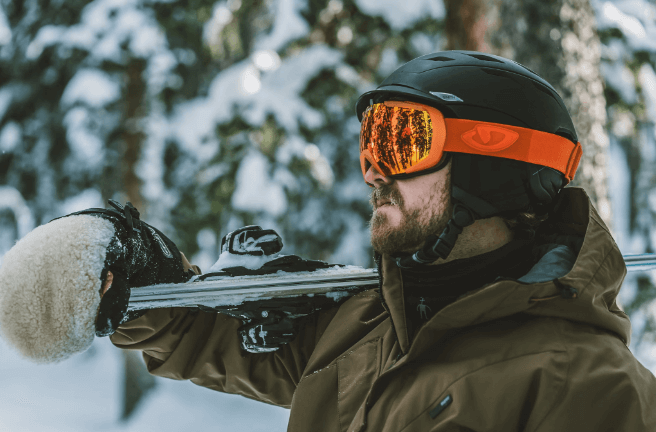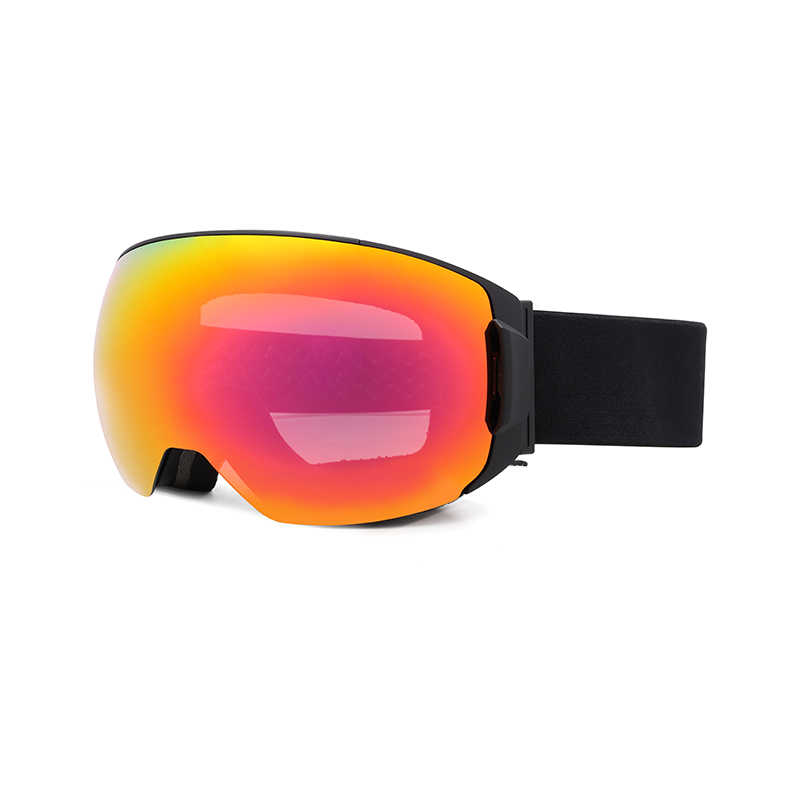El esquí es un deporte emocionante que permite a los aficionados deslizarse por pistas de nieve polvo y disfrutar de la belleza de los paisajes invernales. Sin embargo, una molestia común que puede afectar la experiencia de esquiar son las gafas empañadas. El empañamiento de las gafas de esquí no solo obstruye la visión, sino que también puede suponer un riesgo para la seguridad en las pistas. En este artículo, exploraremos las razones por las que se empañan las gafas de esquí y ofreceremos 10 consejos para evitarlo.
¿Por qué se empañan las gafas?

Las gafas se empañan cuando hay una diferencia de temperatura entre el interior y el exterior de las lentes. Cuando el aire caliente de la cara entra en contacto con la superficie fría de la lente, se produce condensación, lo que provoca el empañamiento. Además, la humedad del sudor y la humedad también pueden contribuir al empañamiento de las gafas. Una ventilación deficiente y un ajuste apretado pueden agravar el problema, atrapando el calor y la humedad en el interior. gafas de esquí.
¿Cómo evitar que las gafas de esquí se empañen?

Elegir las gafas de esquí adecuadas puede marcar una diferencia significativa a la hora de evitar el empañamiento. Busque gafas con revestimiento antivaho o lentes de doble panel que crean una barrera entre tu cara y el aire frío del exterior.
Gafas antivaho Están diseñadas específicamente con recubrimientos avanzados o lentes de doble panel que crean una barrera protectora contra la condensación, evitando así la acumulación de vaho y manteniendo una visión nítida del entorno mientras esquías. Estas características ayudan a regular la temperatura y reducir la condensación, manteniendo una visión nítida en las pistas. Invertir en gafas de nieve antivaho de alta calidad de fabricantes confiables de gafas es un paso esencial para garantizar una experiencia de esquí sin niebla.
8 consejos para evitar que las gafas de esquí se empañen
El empañamiento de las gafas de esquí puede ser una molestia común para los aficionados a los deportes de invierno, pero con las técnicas adecuadas, puedes evitarlo y disfrutar de una visión nítida en las pistas. Aquí tienes 8 consejos para evitar que tus gafas de esquí se empañen:

#1: Ajuste adecuado
Ajustar correctamente las gafas de esquí es fundamental para garantizar la máxima comodidad, claridad y rendimiento durante tus aventuras de esquí. Unas gafas bien ajustadas crean un sellado hermético contra tu cara, minimizando eficazmente la entrada de aire caliente que puede provocar condensación y empañamiento en la lente.
Para lograr el ajuste ideal de sus gafas de esquí, Comience ajustando las correas para asegurarse de que estén ajustadas pero no apretadas.Las correas deben sujetar las gafas cómodamente, evitando que queden huecos que permitan la entrada de aire caliente. Además, Revisa el puente nasal de las gafas. Para asegurar que se ajuste perfectamente a la cara sin ejercer una presión excesiva. Un puente nasal bien ajustado ayuda a sellar cualquier posible entrada de aire caliente, lo que reduce significativamente el riesgo de empañamiento. Además, Tenga en cuenta la forma y el tamaño de las gafas. En relación con la estructura de tu rostro. Diferentes gafas están diseñadas para adaptarse a diferentes formas de rostro, por lo que elegir unas que complementen tus contornos faciales puede mejorar el ajuste y el sellado general.
#2: Evite tocar o limpiar la lente interior
Al tocar la lente interior con guantes o dedos sucios, se corre el riesgo de transferir aceites, suciedad y residuos a la superficie de la lente. Estas sustancias extrañas pueden crear una película que interfiere con las propiedades antivaho de las gafas, lo que a la larga provoca problemas de empañamiento.
Para evitarlo, es fundamental manipular las gafas de esquí con cuidado y utilizar técnicas de limpieza adecuadas. Evite tocar la lente interior innecesariamente, especialmente con las manos sucias o grasientas. Si necesita limpiar la lente, utilice un paño limpio y suave, especialmente diseñado para la limpieza de lentes. Evite usar materiales ásperos o abrasivos que puedan rayar la lente o dañar el revestimiento antivaho.
#3: Utilice insertos, toallitas o aerosoles antivaho
Para evitar que tus gafas de esquí se empañen y mantener una visibilidad nítida durante tus aventuras, considera usar insertos, toallitas o aerosoles antivaho como soluciones eficaces. Estos productos especializados están diseñados para crear una barrera protectora en la superficie de la lente, evitando la condensación y la formación de vaho.
Los insertos, toallitas o aerosoles antivaho ofrecen una capa adicional de protección contra el empañamiento, especialmente en entornos difíciles o con alta humedad. Estos productos suelen contener ingredientes que ayudan a absorber la humedad e inhiben la formación de condensación en la lente. Al aplicar tratamientos antivaho a las gafas antes de salir a esquiar, puede combatir el empañamiento de forma proactiva y mantener una visión despejada durante toda la sesión.
#4: Asegúrese de que las rejillas de ventilación estén abiertas y despejadas
Asegurarse de que las rejillas de ventilación de las gafas de esquí estén abiertas y sin obstrucciones es crucial para evitar el empañamiento y mantener una visibilidad óptima. El sistema de ventilación de las gafas es fundamental para facilitar el flujo de aire y regular la temperatura dentro de la lente, lo que ayuda a reducir la acumulación de humedad y condensación que pueden provocar problemas de empañamiento.
Una ventilación adecuada es esencial para que el aire cálido y húmedo escape del interior de las gafas, evitando que se condense en la superficie más fría de la lente. Para asegurarse de que las rejillas de ventilación estén abiertas y despejadas, Inspeccionarlos y limpiarlos periódicamente para eliminar cualquier residuo, nieveu obstrucciones que puedan bloquear el flujo de aire. Las rejillas de ventilación bloqueadas pueden dificultar la circulación del aire, lo que provoca humedad atrapada y un mayor riesgo de empañamiento.

#5: Mantenga las gafas de esquí calientes
Mantener las gafas calientes ayuda a minimizar la diferencia de temperatura entre el interior y el exterior de la lente, lo que reduce la probabilidad de acumulación de condensación y niebla.
Para mantener calientes tus gafas de esquí, considera guárdelos en una bolsa o bolsillo aislante cerca de su cuerpo cuando no los useEsto ayuda a mantener una temperatura constante en las gafas, evitando que se enfríen demasiado y se empañen al exponerse al aire caliente. Evite dejar las gafas en un ambiente frío durante un período prolongado, ya que esto puede aumentar la diferencia de temperatura y contribuir al empañamiento. Además, considere... usando un estuche para gafas o una bolsa protectora de almacenamiento para proteger sus gafas de los elementos externos y los cambios de temperatura.
#6: Evite colocar las gafas encima del casco
Para evitar el empañamiento y mantener la claridad de las gafas de esquí, es importante evitar colocarlas sobre el casco cuando no se estén usando. Esto puede retener el calor y la humedad entre las gafas y el casco, creando un ambiente propicio para la condensación y la formación de vaho.
Colocar las gafas de esquí encima del casco puede restringir el flujo de aire e inhibir la evaporación de la humedad, lo que aumenta la humedad en el interior de las gafas y aumenta la probabilidad de que se empañen. Si evita este error común y guarda las gafas en un lugar fresco y seco, minimizará el riesgo de condensación y garantizará una visibilidad clara en las pistas.
#7: Cómo elegir ropa transpirable
Los tejidos transpirables permiten que la humedad y el calor escapen, manteniéndote seco y cómodo durante todo el tiempo que paseas en las pistas. Al elegir prendas que priorizan la transpirabilidad, puedes regular tu temperatura corporal con mayor eficacia, evitar el sobrecalentamiento y mejorar tu experiencia de esquí.
Al seleccionar ropa de esquí, busque materiales que estén diseñados específicamente para ofrecer transpirabilidad, como Tejidos que absorben la humedad y paneles de ventilaciónEstos tejidos están diseñados para absorber el sudor de la piel y favorecer la ventilación, lo que ayuda a prevenir la acumulación de humedad y a mantener una temperatura corporal agradable. La ropa transpirable no solo te mantiene seco y cómodo, sino que también reduce el riesgo de rozaduras e irritación durante la actividad física.
#8: Cómo evitar la sudoración excesiva
La sudoración excesiva puede provocar malestar, deshidratación y posibles riesgos para la salud, por lo que es fundamental adoptar estrategias para controlar la temperatura corporal y prevenir el sobrecalentamiento. Una forma de evitar la sudoración excesiva es... vestir apropiadamente para las condiciones climáticas y su nivel de actividad. Mantenerse hidratado También es crucial para prevenir la sudoración excesiva. Beber agua regularmente antes, durante y después de tus sesiones de esquí para reponer los líquidos perdidos a través del sudor y mantener niveles óptimos de hidratación. Evitar la cafeína y el alcoholLa sudoración, que puede contribuir a la deshidratación, también es importante para controlar la respuesta del cuerpo a la sudoración. Además, controlar el ritmo y tomar descansos según sea necesario puede ayudar a prevenir la sudoración excesiva y el sobrecalentamiento.
Conclusión
En conclusión, las gafas empañadas pueden ser un obstáculo frustrante para los esquiadores, pero con las medidas de prevención adecuadas, es posible disfrutar de una visión nítida en las pistas. Al elegir gafas antivaho, mantener un ajuste adecuado y seguir estos consejos, puede minimizar el empañamiento y mejorar su experiencia de esquí. Recuerde cuidar su equipo y estar preparado para cualquier condición climática para aprovechar al máximo su tiempo en la montaña.

25年-香港展邀请函(横屏-英文版)-1024x358.jpg)


